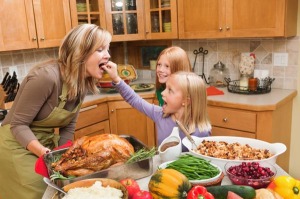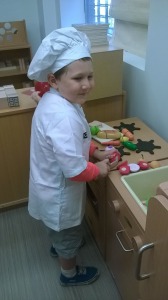A recent conversation between my 7-year-old son and my mother-in-law went something like this:
Mother-in-law: “I have a friend whose grandson visited last year for Thanksgiving. She had worked for days to make a big, beautiful dinner for everyone. After all of that work, she sat the food down at the table and her grandson said, ‘Ewww! I don’t want that. Yuck!!’ ”
My son sat wide-eyed, taking in her tale. He nodded. “Okaaaay.”
I jumped in and we talked about trying a bite of everything on the plate. And even more important, we talked about why that was not a nice thing to say to someone who worked so hard to make a beautiful meal. We told him that this is a special time to be together as a family, to sit and talk for a while. In other words, this is not the time to bounce out of the chair for one more game of catch. And hey, we added, the sweet potatoes will have marshmallows on top!
“I don’t like sweet potatoes,” he announced casually.
Well, we’ll see how this goes.
The holidays are a time of traveling, cooking, cleaning, planning, cooking more, making lists and counting chairs and napkins. But it is also the time of year when parents are considering how their 2-year-old will hold up during a Thanksgiving meal that starts at 7 p.m. Or how their 10-year-old daughter will react when she opens a present from Great Aunt Edna to find a puppy sweater that she would have liked when she was 3. Or whether their 7-year-old son will understand the importance of togetherness, love and thankfulness when the family gathers around a table.
It’s a stressful time for many people. And even though we love our kids and they are lots of fun, they often magnify that stress. Even worse, our stress can trickle down to them, turning a happy holiday into a Noel nightmare.
I tried to break it down (another list!) so we can all do more than just get through the holidays. Here are ways to help children — and let’s face it, ourselves — think about what it means to be generous, kind, loved and loving in the coming weeks.
Speaking of food . . .
Megan Barna is an outpatient dietitian at Children’s National Medical Center in the District. She often hears from parents who say that they want their kids to stop eating sweets but then admit they have a secret stash of soda for themselves. If you want them to eat well, she said, you have to eat well. Children model their behavior after ours. She shared several suggestions to encourage children to sit and eat (yes, really) with the rest of the family.
● Depending on their age, take them with you when you shop for the holiday meal and ask for their input. Obviously, they don’t get to dictate what will be served. But this is the time to show them your list and then give them choices: Should our vegetable be carrots, broccoli or cauliflower?
● Let this time of year be a big experiment. We want our children to appreciate food, and the holidays offer great opportunities, Barna said. So talk about the food, explain what’s coming and what it will taste like. So they don’t usually eat Brussels sprouts? I didn’t think I liked them either — because my mother used to boil (blech) the odd little veggie. I will talk to my kids about that and how we will prepare them differently, roasting them so they are crispy and tasty instead of dull and mushy, like when I was growing up.
● Bring the kids into the kitchen. Not only will having them come into the kitchen help them understand and appreciate all the hard work that goes into family meals, but also, the more children are involved in the process, the more they will try new foods over time. And yes, children of any age can be involved. Give your toddler a spoon and ask her to help mix something. Have your second-grader tear up the lettuce for a salad. Give your tween a sponge and have him wash the table. “Make them feel like you’re on the same team,” Barna said. They will have pride and ownership in the meal, which will entice them to sit longer and, hopefully, try a few new things.
● Eat normally leading up to the big meal. I don’t know about you, but I try to not eat much leading up to family dinners on big holidays, in an attempt to “save room” for all that good food. Don’t do that. Make sure that you — and the kids — eat normal meals and snacks that day, Barna said. Incorporate fiber and protein. You want kids to not feel crazed with hunger, particularly if they aren’t going to eat much on their rather different-from-usual plate.
● They will follow your lead. Remember that your behavior will influence your kids. If you don’t want them to eat so many sweets, don’t go gorging on the pumpkin pie in the corner at cleanup time.
● End the day on a healthy note. Take a walk with everyone after big family dinners. You can enjoy one another’s company, fresh air or the pretty neighborhood lights.
Minimizing stress
Eleanor Mackey, a child psychologist, also with Children’s, said parents need to recognize that as much as this is a time to enjoy, all of the hustle and bustle and togetherness also might create stress for kids. “Planning ahead can go a long way to help prevent problems,” she said. “The last thing anyone wants is a meltdown at a big family gathering.” Here are her suggestions.
● Think ahead. Figure out what you can do to structure the event for the least negative impact on the family’s typical schedule, and prepare the kids for what to expect. In other words, don’t do dinner at 8 p.m. if you have children who go to bed at 7:30. Explain to them either before you go to a gathering or as the holiday nears how things will work.
● Let kids know what your expectations are. Give them a timetable, such as: So when we get there, you’ll have time to play with your cousins. And then when it’s dinnertime, we all will sit at the table. I expect you to do that for at least 30 minutes. Then you can go play with everyone again. “Preparing kids ahead of time and coaching them about what’s appropriate goes a long way,” Mackey said.
● About that weird present. Again, preparation is key. Kids have bad impulse control and may slip when they get a pair of fluorescent Santa socks for Hanukkah. But tell them before you go out that if someone gives them a present, it’s because “they like you, and sometimes they might guess wrong. It’s really important that they just thought about you, and they thought they were getting you something you would like,” Mackey said. Then demonstrate what you would say: It was so nice of you to think of me when you got this. Boom.
● Be realistic. Set developmentally appropriate expectations of, for example, how long your child can actually sit. Or how much conversing with adults will actually happen. Think your child can realistically sit nicely for 15 minutes? Let that be the thing you focus on. Want your son to speak kindly to an aunt he doesn’t know? Practice that conversation in advance. It may help you, too, so you don’t get unreasonably annoyed when your 5-year-old wants to leave the table before everyone is finished.
Add a dollop of gratitude
Related: How to encourage kids to ‘give back’
Here’s the part that gets me the most about holidays. I want our sons to understand that there’s a reason it’s called Thanksgiving. And that just because it’s Christmas doesn’t mean everyone who comes to our door will be bearing gifts (please, goodness, NO).
So I spoke with Richard Weissbourd, co-director of the Making Caring Common Project at Harvard. His mission is to help parents, educators and communities raise kind children. Here are his suggestions for serving up a side of gratitude with your holiday meal.
● Have a gratitude action. Weissbourd suggests you ask your children to think about someone outside of the family who has helped them. Think about people you don’t normally thank — the custodian at school, the mail carrier, the bus driver. Then do something to express appreciation, whether that’s a note, a gift or an offer to do something helpful. “It’s like putting people on kids’ radar who they aren’t normally grateful for,” he said. And hopefully, these specific activities will spur ongoing activities beyond the holidays.
● Commit to a service or organization as a family. Talk to one another about what you most care about. Homelessness? Animal welfare? Then find an organization you can get behind, and make a promise to do something monthly for that group or that cause. “I always worry about the one-shot things,” Weissbourd said. And that’s true — just look at the food-bank volunteer wait lists at this time of year. Spread it out, and remember that these places often are asking for help year-round.
● Don’t inundate kids with gifts. When you give too many gifts, the appreciation goes out the window. “You want them to be thankful for gifts, including thankful to you,” he said. “They often assume gifts from the family don’t deserve to be noted. But kids should note them.” And kids of any age should say thank you when they get a gift, he said. Which they will certainly understand if we do the same, right?






